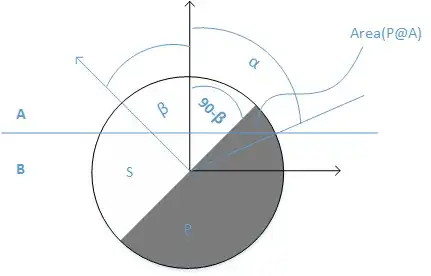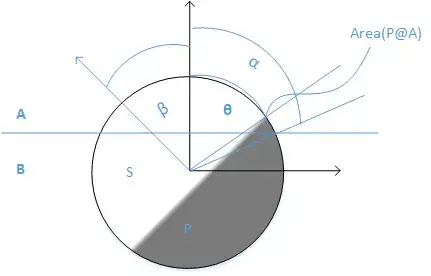Consider the following background information:
I have a sphere that equally divided in to two hemisphere P and S. There is a plane that separate two different zone. Upper zone called A and lower zone called B. The angle $\alpha$ defined where the sphere is touching the intersection plane. So $\alpha$ larger means sphere is more in zone A and vice versa. The angle $\beta$ defines the orientation of the sphere. Schematic representation of this is below.
To calculate the area of $P$ portion of the sphere into $A$ is given by following equation $$ \mathrm{Area}_{P-A}= r^2\int_{\theta=\frac{\pi}{2}-\beta}^\alpha \int_{\phi=\arcsin(1/(\tan\theta \tan \beta))} ^{\pi -\arcsin(1/(\tan\theta \tan \beta)} \sin\theta\; d\theta d\phi. $$
After solving this equation we can get the following solution. $$ \textrm{Area}_{P-A}= 2 r^2 \left\{ \cos (\alpha) \sin ^{-1}(\cot (\alpha) \cot (\beta)) -\tan ^{-1}\left(\frac{\cos (\beta)}{\sqrt{\sin ^2(\beta)-\cos ^2(\alpha)}}\right)\right\}+\pi r^2 (1-\cos (\alpha)). $$
Note that the solution is defined as a function of $\alpha$ and $\beta$. If we change the value of $\alpha $ and $\beta$, the area of P into A will change eventually.
Now consider more complex case where $P$ and $S$ are not equal hemisphere.

Question: If $P$ and $S$ are not equal, then what should I consider if I want to calculate the area of $P$ into $A$ as a function of $\alpha$ , $\theta$ and $\beta$? Here $\theta$ defines the distance of the cap edge from center.
Note:
I have seen this question:
Calculate the area on a sphere of the intersection of two spherical caps
where it solves for two spherical cap separate each other by an angle and calculate the area of their intersection. In my problem, I would like to calculate the area of one spherical cap when it cross a fixed intersection. I am looking for an analytical solution like the top one so that I can be able to calculate area when sphere going up and down and it rotate.